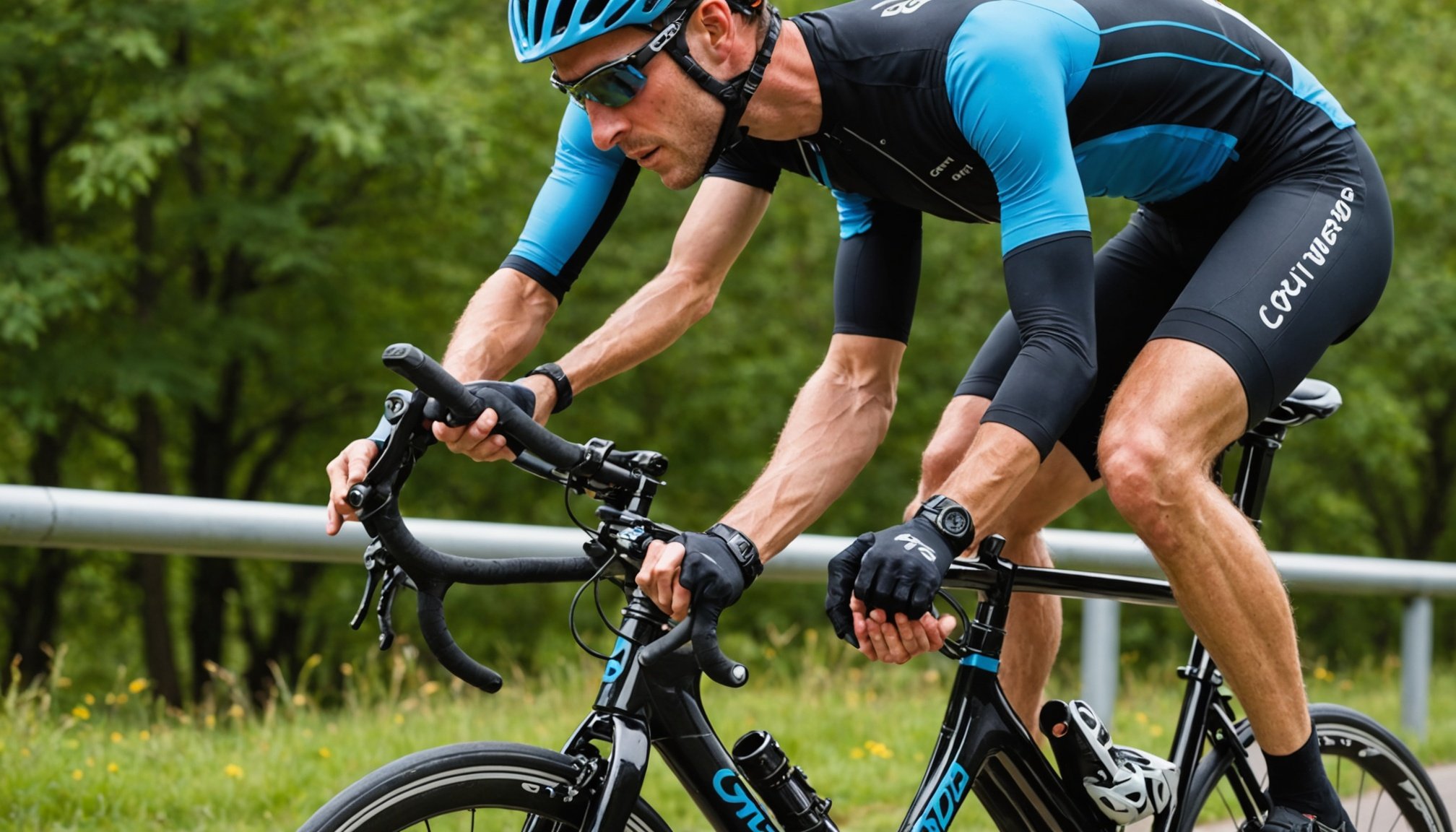Top Ergonomic Tips for Cyclists: Say Goodbye to Wrist Pain!
Understanding the Importance of Ergonomics in Cycling
When it comes to cycling, ergonomics plays a crucial role in ensuring a comfortable and injury-free ride. One of the most common issues cyclists face is wrist pain, which can be debilitating and affect the overall cycling experience. Here’s why ergonomics is so important:
“Wrist injuries from being in the tech world – you’re seeing so many chronic overuse injuries in wrists,” notes Jutta Schneider, a physical therapist and dedicated cyclist. “The upright riding position doesn’t load your upper extremities so much, and that’s helpful.”
Topic to read : Discover Your Ideal Heart Rate Zone for Maximum Fat Burning While Cycling
Choosing the Right Bike Fit
The first step in preventing wrist pain is to ensure your bike is fitted correctly to your body. Here are some key points to consider:
Riding Position
The riding position is critical in determining the strain on your wrists and hands. An upright posture, as opposed to a forward-leaning position, can significantly reduce strain.
Topic to read : Ultimate Guide to Effective Pacing Strategies for Endurance Events: Master Multi-Day Sports Competitions!
“Low handlebars and a really forward posture can be hard on the neck – and when you add rotation to the mix, it’s especially taxing,” explains Schneider. “Upright posture can also help the lumbar spine, hands, and wrists.”
Handlebar Height and Type
The height and type of handlebars can make a significant difference. Upright handlebars are often recommended for their ergonomic benefits.
“Look into several models by Electra bikes, with upright handlebars but 700C (big) wheels. Other advantages for women are that the Electra bikes are very easy on the knees,” suggests a cyclist who switched to upright handlebars after knee replacement surgery.
Selecting the Right Handlebar Grips
Handlebar grips are another crucial aspect of ergonomic cycling. Here’s what you need to know:
Shape and Length
The shape and length of the grips should be tailored to your hand size and riding style.
“Most grips are between 130 mm and 140 mm in length. But there are shorter 90mm options for riders with small hands and 150mm grips for riders with larger hands,” explains an article on mountain bike grips.
Cushioning and Material
The amount of cushioning in the grips is vital for comfort and pain relief.
“Firmer grips offer a more athletic, responsive connection to your bars and a more sensitive reading of the terrain beneath the tires. Softer material provides more cushion, absorption, and comfort, which can be preferred for longer rides, certain hand or wrist injuries, or just a personal preference,” notes an expert review on mountain bike grips.
Top Recommendations for Ergonomic Grips
Here are some highly recommended ergonomic grips that can help alleviate wrist pain:
ODI Reflex Grips
- Diameter: 33.5mm or 34.5mm
- Length: 135mm
- Weight: 108g
- Features: Raised grid palm, ribbed mushroom panel, waffle pattern under fingertips for excellent cushioning and grip.
- Reasons to Buy: High level of comfort and vibration absorption, premium quality construction.
- Reasons to Avoid: Possibly too large for some hand sizes.
Ergon GA3 Grips
- Features: Flared rubber grip for wrist support, conforms to the shape of the rider’s hands.
- Reasons to Buy: Provides wrist support, comfortable for long rides, especially for riders with wrist or hand injuries.
- Reasons to Avoid: May not be suitable for all riding styles.
Lizard Skins Gradient Grips
- Diameter: 30.5-36.6mm
- Length: 136mm
- Weight: 115g
- Features: Ergonomic shape, noticeable support and pressure relief, slim, rounded bar clamp.
- Reasons to Buy: Ergonomic but not ungainly shape, additional finger grip from flange.
- Reasons to Avoid: Prescriptive position may not suit all riders, not the most cushioned grip, expensive.
Table: Comparative Analysis of Top Ergonomic Grips
| Grip Model | Diameter (mm) | Length (mm) | Weight (g) | Key Features | Reasons to Buy | Reasons to Avoid |
|---|---|---|---|---|---|---|
| ODI Reflex | 33.5 or 34.5 | 135 | 108 | Raised grid palm, ribbed mushroom panel, waffle pattern | High comfort, vibration absorption, premium quality | Possibly too large for some hand sizes |
| Ergon GA3 | Variable | Variable | Variable | Flared rubber grip for wrist support | Wrist support, comfortable for long rides | May not be suitable for all riding styles |
| Lizard Skins Gradient | 30.5-36.6 | 136 | 115 | Ergonomic shape, support and pressure relief, slim bar clamp | Ergonomic shape, additional finger grip | Prescriptive position, not the most cushioned, expensive |
| DMR Deathgrip | Variable | Variable | Variable | Multiple grip patterns, eccentric design | Comfort, ultimate grip, adjustable | May be too bulky for some riders |
Practical Tips for Reducing Wrist Pain
Here are some practical tips to help you reduce wrist pain while cycling:
Adjust Your Handlebars
- Ensure your handlebars are at a comfortable height. If you find yourself leaning forward too much, consider adjusting the stem or using upright handlebars.
Use Ergonomic Grips
- Choose grips that are designed to support your wrists and hands. Ergonomic grips with flared sections or integrated bar ends can provide additional support.
Maintain Proper Riding Position
- Keep your back straight and avoid leaning forward excessively. This can help distribute the weight more evenly and reduce strain on your wrists.
Take Regular Breaks
- During long rides, take regular breaks to stretch your hands, wrists, and arms. This can help prevent fatigue and reduce the risk of injury.
Consult a Healthcare Professional
- If you experience persistent wrist pain, consult a healthcare professional. They can provide personalized advice and treatment to help alleviate the pain.
Real-Life Examples and Anecdotes
Switching to Upright Handlebars
One cyclist shared their experience of switching to upright handlebars after total knee replacement surgery: “I had total knee replacement surgery and I am riding my Electra with no pain or strain. The Electra bikes are very easy on the knees, and the upright handlebars have been a game-changer for my wrists and back.”
Using Ergonomic Grips
Another cyclist found relief by using ergonomic grips: “I have one of those ‘horrid beach cruisers,’ a lowly single-speed Schwinn. The stock handlebars were a little too low, so I swapped them for aftermarket ‘bars with about 4-inches of additional rise. With the grips dropped a few degrees, the ergonomics are now pretty near perfect for my wrists and back.”
Cycling is a wonderful way to stay active and enjoy the outdoors, but it doesn’t have to come at the cost of wrist pain. By choosing the right bike fit, selecting ergonomic grips, and maintaining a proper riding position, you can significantly reduce the strain on your wrists and hands.
As Schneider emphasizes, “It’s a very natural position to be in. The upright riding position doesn’t load your upper extremities so much, and that’s helpful.” By following these tips and recommendations, you can ensure a more comfortable and enjoyable cycling experience, whether you’re touring the city or hitting the trails on your mountain bike.
So, the next time you hop on your bike, remember that a little attention to ergonomics can go a long way in keeping you pain-free and cycling happily for years to come.











